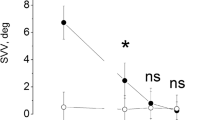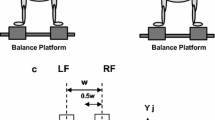Summary
A photographic technique was used to study the evolution of lateral head-tilt following hemilabyrinthectomy in adult cats. Animals were maintained post-operatively in normally lit conditions (LM cats), in total darkness (DM cats), or in stroboscopic light.
In LM cats, the head tilt peaked at 45 degrees (with the lesionned side down) on the second post-operative day, and decreased to about 0 degree within about 10 days. This evolution was followed by rebounds of head-tilt to larger angles before a stable compensated head position could be maintained (approximately at the end of the third post-operative month).
In DM cats, the head remained tilted by a large angle throughout the duration of the dark period. Re-exposure to light was followed by a rapid decrease of head-tilt.
In stroboscopic light, the evolution of head-tilt was found to be closely similar to that in the normally lit condition.
Finally, when put back in the dark at a late post-operative stage, already compensated animals were found to loose their symmetrical head position, and to re-acquire a strong head tilt. This effect resumed on re-exposure to light.
It is inferred that static visual input is a necessary condition for compensation of the postural deficits of hemi-labyrinthectomy in the cat. Maintenance of a stable head posture also depends upon continuous availability of visual input.
Similar content being viewed by others
References
Azzena, G.B.: Role of the spinal cord in compensating the effects of hemilabyrinthectomy. Arch. ital. Biol. 107, 43–53 (1969)
Berthoz, A., Andersen, J.: Frequency analysis of vestibular influence on extensor motoneurons. II. Relationship between neck and forelimb extensors. Brain Res. 34, 376–380 (1971)
Courjon, J.H., Jeannerod, M., Ossuzio, I., Schmid, R.: The role of vision in compensation of vestibulo-ocular reflex after hemilabyrinthectomy in the cat. Exp. Brain Res. 28, 235–248 (1977)
Dow, R.S.: The effects of bilateral and unilateral labyrinthectomy in monkey, baboon, and chimpanzee. Amer. J. Physiol. 121, 392–399 (1938)
Ewald, J.R.: Physiologische Untersuchungen über das Endorgan des nervus octavus. 325 pp. Wiesbaden: Bergmann Verlag 1892
Flourens, J.P.N.: Recherches expérimentales sur les propriétés et les fonctions du système nerveux, dans les animaux vertébrés. Paris: Baillère 1842
Ito, M.: Cerebellar learning control of vestibulo-ocular mechanisms. In: Mechanisms in transmission of signals for conscious behaviour (ed. T. Desiraju), pp. 1–21. Amsterdam: Elsevier 1976
Kolb, G.: Untersuchungen über zentrale Kompensation und Kompensationsbewegungen einseitig entstateter Frösche. Z. vergl. Physiol. 37, 136–160 (1955)
Lacour, M., Roll, J.P., Appaix, M.: Modifications and development of spinal reflexes in the alert baboon (papio papio) following an unilateral vestibular neurotomy. Brain Res. 113, 255–269 (1976)
Llinás, R., Walton, R., Hillman, D.E., Sotelo, C.: Inferior olive: its role in motor learning. Science 190, 1230–1231 (1975)
Maekawa, K.: The visual input to the cerebellar floculus. In: Golgi centennial symposium (ed. M. Santini), pp. 281–293. New York: Raven Press 1975
Maekawa, K., Simpson, J.I.: Climbing fiber activation of Purkinje cells in the flocculus by impulses transferred through the visual pathway. Brain Res. 39, 245–251 (1972)
Magnus, R.: Körperstellung. Berlin: Springer 1924
Marr, D.: A theory for cerebellar cortex. J. Physiol. (Lond.) 202, 437–470 (1969)
McCabe, B.F., Ryu, G.H.: Experiments on vestibular compensation. Laryngoscope (St. Louis) 79, 1728–1736 (1969)
McCabe, B.F., Ryu, G.H., Sekitani, T.: Further experiments on vestibular compensation. Laryngoscope (St. Louis) 82, 381 (1972)
Precht, W.: Characteristics of vestibular neurons after acute and chronic labyrinthine destruction. In: Vestibular system. Part II. Handbook of sensory physiology (ed. H.H. Kornhuber), pp. 451–462. Berlin: Springer 1974
Precht, W., Shimazu, H., Markham, C.H.: A mechanism of central compensation of vestibular function following hemilabyrinthectomy. J. Neurophysiol. 29, 996–1010 (1966)
Putkonen, P.T.S., Courjon, J.H., Jeannerod, M., Berthoz, A., Vital Durand, F.: Influence de la vision sur la compensation des effets posturaux de la labyrinthectomie. J. Physiol. (Paris) 7, 27A (1976)
Schäfer, K.P., Meyer, D.L.: Compensation of vestibular lesions. In: Vestibular system, Part II, Handbook of sensory physiology (ed. H.H. Kornhuber), pp. 463–490. Berlin: Springer 1974
Wilson, V.J., Yoshida, M.: Bilateral connections between labyrinths and neck motoneurons. Brain Res. 13, 603–607 (1969)
Author information
Authors and Affiliations
Rights and permissions
About this article
Cite this article
Putkonen, P.T.S., Courjon, J.H. & Jeannerod, M. Compensation of postural effects of hemilabyrinthectomy in the cat. A sensory substitution process?. Exp Brain Res 28, 249–257 (1977). https://doi.org/10.1007/BF00235707
Received:
Issue Date:
DOI: https://doi.org/10.1007/BF00235707




